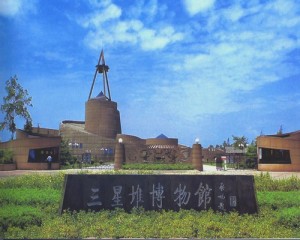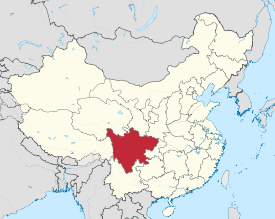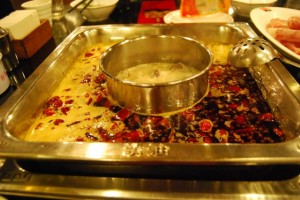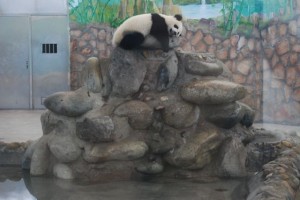Better Know a… Province (Part One) Posted by sasha on Oct 4, 2012 in Culture, Uncategorized
So far, we’ve covered two of China’s massive municipalities – Beijing and Shanghai. We’ll save the other two – Tianjin and Chongqing – for later, and today we’ll begin our tour around China’s many provinces. For this first provincial introduction, we’re heading to the sight of my last vacation – Sichuan (四川 – sì chuān). Famed for it’s spicy food, stunning landscapes, and of course, delightfully cute pandas, Sichuan province is one of the most fascinating places in China.
History
The name Sichuan is actually a shortened version of the original, which meant “The Four Circuits of the Rivers and Gorges” (川峡四路 – chuān xiá sì lù). Long before people, dinosaurs roamed the land. Even the pandas have a longer history than humans here. Evidence of civilizations here date back as far as the 15th century BC. During the Zhou Dynasty, two rival kingdoms were established – the Shu (古蜀 – gǔ shǔ) and Ba (巴国 – ba guó). An important archaeological discovery called the Sanxingdui ruins (三星堆遗址 – sān xīng duī yí zhǐ) proved the existence of the Shu kingdom, which previously had no actual record. This was the first area of China to be settled by the Han people, as the first organized migration occurred way back in 500 BC. Around the 2nd century BC, the Qin Dynasty took over, conquering both the Shu and Ba. Through successive Dynasties, Sichuan saw a variety of power struggles.
During the Second Sino-Japanese War in what was then the Republic of China, Chongqing – which was then a part of the province – was made the capital. Here Chiang Kai-shek and the KMT made their base, until they were eventually defeated by the Communists. Under the newly founded People’s Republic of China, Sichuan was the most populous province for many years, until Chongqing and its surrounding area was made a municipality.
A dark part of Sichuan’s history occurred in May 2008, when an 8.0-magnitude earthquake rocked the region, killing around 70,000 and leaving millions homeless. Since then, the province has done its best to rebuild and move forward.
Geography
Sichuan is located in southwest China, and it shares a border with Qinghai, Gansu, Shaanxi, Chongqing, Guizhou, Yunnan, and Tibet. After Chongqing split, Sichuan became the 3rd largest province in China, behind Xinjiang and Inner Mongolia. Generally speaking, the western part of the province is full of plateaus and mountainous regions, while the east is mostly located in the fertile Sichuan basin. The province is well-known for its many mountains, the tallest of which is Gongga Shan (贡嘎山 – gòng gā shān), towering at 7,556 meters. The famed Yangtze River (长江 – cháng jiāng) also flows through Sichuan. It can be said that Sichuan is somewhat of a geographical paradise, as it has: mountains, rivers, caves, lakes, waterfalls, basins, hills, plains, and even hot springs.
Climate
As a very large province with distinctly different regions, Sichuan’s climate varies depending on where you are. The eastern area has a humid subtropical climate, with hot and humid summers that seem to drag on forever. Summers also feature plenty of rainfall. As far as winters go, they are generally short, cool, and dry. The mountainous areas of the west experience more sunshine, but they also get harsh winters. Of course, the temperature goes down the higher you get.
Population
Sichuan has a population of over 80 million, with the majority being Han Chinese. When it comes to the far western parts of the province, however, you’ll find few Han people and far more minorities. There are many Tibetans, Yi, Qiang and Naxi people living in Sichuan today. Of course, there are far more people in the eastern region than the western.
Culture
As it has a diverse population, Sichuan also has a diverse culture. A variety of languages are spoken here, the most common of which is Sichuanese (四川话 – sì chuān huà). Although it is classified as a dialect of Mandarin, it really is quite different. Students of standard Mandarin will find it nearly impossible to understand the local language. With so many Tibetans living in Sichuan, Tibetan culture and language obviously have a big influence.
When most people think of Sichuan culture, they probably think of two things – Sichuan opera (川剧 – chuān jù) and spicy food. The opera performances are famous for the changing faces and occasional fire spitting. As far as the food goes, there’s a saying about Sichuan food that goes “one dish, one shape, hundreds of dishes, hundreds of tastes.” It’s known to be mouth-numbingly spicy, as a special hot pepper called huajiao (花椒 – huā jiāo) is used very liberally. Sichuan hot pot (四川火锅 – sì chuān huǒ guō) is famous all over China, and rightfully so. Many other famous Chinese dishes also come from Sichuan, including the classic Kung Pao chicken.
Famous Places
When most people come to Sichuan, they start in the capital city of Chengdu. The main attraction here is the Giant Panda Breeding and Research Center. Tourists flock here everyday to watch the cuddly panda bears munching on bamboo and playing around. A trip here is also quite educational, as visitors can learn about the efforts to breed the endangered animals in captivity. There are plenty of other places in Sichuan to see the national animal in addition to this one.
Other notable attractions include the holy Mt. Emei (峨眉山 – É méi shān), one of the Four Sacred Buddhist Mountains in China. Speaking of Buddha, you’ll also find the world’s largest Buddha nearby in Leshan. The Leshan Giant Buddha (乐山大佛 – lè shān dà fó) was built in the Tang Dynasty, and it stands at 71 meters.
Sichuan’s most famous places are further north, though. Here, you’ll find Jiuzhaigou (九寨沟 – jiǔ zhài gōu) and Huanglong (黄龙 – huáng lóng), two stunning national parks that are both UNESCO World Heritage Sites. The natural beauty of China really shines in these scenic areas that are full of mountains, lakes, waterfalls, and much more.
With so many beautiful sights, a long history, a diverse culture, and some of the best food on Earth, Sichuan should be high atop anyone’s list of places to visit. Having recently returned from a two-week trip there, I’d be hard pressed to find another place in China that I’ve enjoyed more. Keep an eye on the blog in the months to come for a variety of videos and stories from my trip there. In the meantime, keep learning Chinese with a new word everyday on our new Google gadget.

Build vocabulary, practice pronunciation, and more with Transparent Language Online. Available anytime, anywhere, on any device.
About the Author: sasha
Sasha is an English teacher, writer, photographer, and videographer from the great state of Michigan. Upon graduating from Michigan State University, he moved to China and spent 5+ years living, working, studying, and traveling there. He also studied Indonesian Language & Culture in Bali for a year. He and his wife run the travel blog Grateful Gypsies, and they're currently trying the digital nomad lifestyle across Latin America.










Leave a comment: